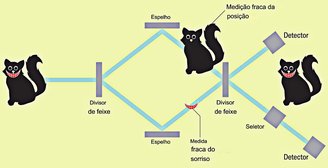In an experiment published in the New Journal of Physics in 2013, a team of physicists led by Yakir Aharonov from Chapman University in the USA introduces a “laughing cat” similar to the one in the book Alice in Wonderland.
The phenomenon under consideration is called “Quantum Cheshire Cat”It suggests that certain properties of quantum particles can be separated from the particle itself.
The concept was tested on an interferometer, an optical instrument that splits two beams of light and then recombines them in an interference pattern. What the authors were trying to prove was that, just like Alice’s cat’s enigmatic smile, a particle can follow one path while its property (such as spin or polarization) follows another.
New Quantum Cheshire Cat Experiment
However, even after the theory was confirmed by subsequent experiments with neutrons and photons, this event sparked heated debate in the scientific community.
Critics argue that the effects can be explained using already known quantum principles (such as wave-particle duality or interference effects)without having to create a new phenomenon.
Aharonov and his colleagues recently proposed a new theoretical approach to avoid resorting to “weak measurements,” one of the main arguments of his critics. In this scenario, they trapped a particle on one side of a split cylinder. In this way, the particle’s spin could be detected on the other side even before the particle passed the splitter.
As expected, the new test has generated new criticism as well as interest. One of them was German physicist Holger Hofmann of Hiroshima University in Japan. questions whether the experiment actually proves this “disembodied” spin transfer. Another critic from UFMG, Brazilian Pablo Saldanha, states that “all results can be explained” […] as simple interference effects,” he explains. Scientific American.
Possible applications of the quantum Cheshire cat

Physicist Sandu Popescu of the University of Bristol in England, who co-authored the new study published in the journal Physical Review A and who also collaborated with Aharonov on the 2013 paper, defends the new approach: “We have developed a completely new method to combine information from pre- and post-experimental measurements.” “, he tells Scientific American.
Arguing that “nobody understands quantum mechanics”, the physicist claims that broader questions arise when it comes to the nature of reality at subatomic scales and the limits of our ability to measure and interpret this phenomenon. Although Saldanha and Hofmann’s positions are correct, he says they may be “missing the center point” of the debate by focusing on secondary dimensions.
Without going into whether the events are true or not, Popescu argues: believes quantum Cheshire cat concept could facilitate new technological applicationsIt is the transfer of information or energy without the need to move a physical particle of not only light but also matter.
Did you like the content? Tell us on our social networks and share the article with your friends who enjoy the fantastic world of quantum physics. Until later!
Source: Tec Mundo
I’m Blaine Morgan, an experienced journalist and writer with over 8 years of experience in the tech industry. My expertise lies in writing about technology news and trends, covering everything from cutting-edge gadgets to emerging software developments. I’ve written for several leading publications including Gadget Onus where I am an author.











